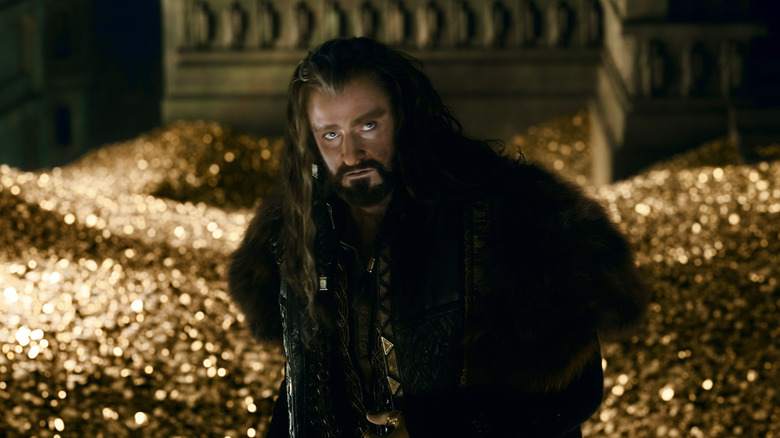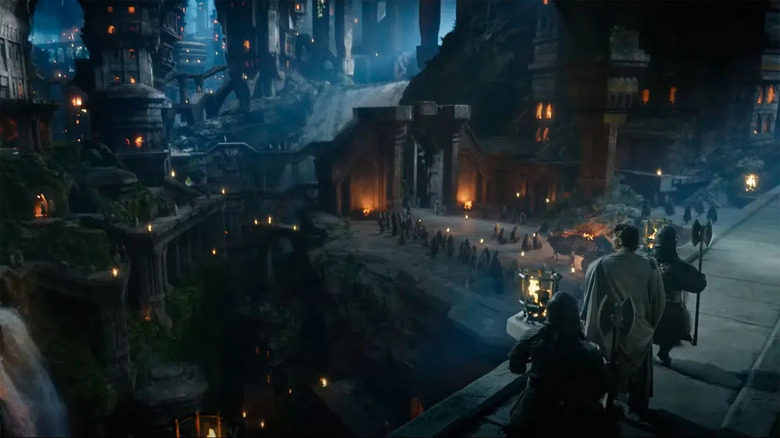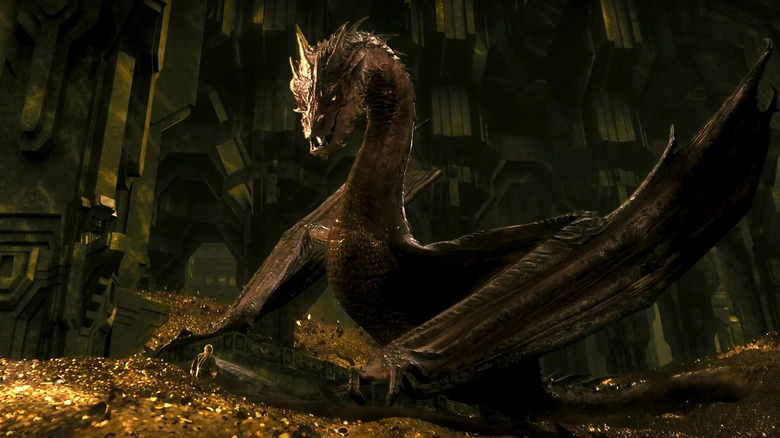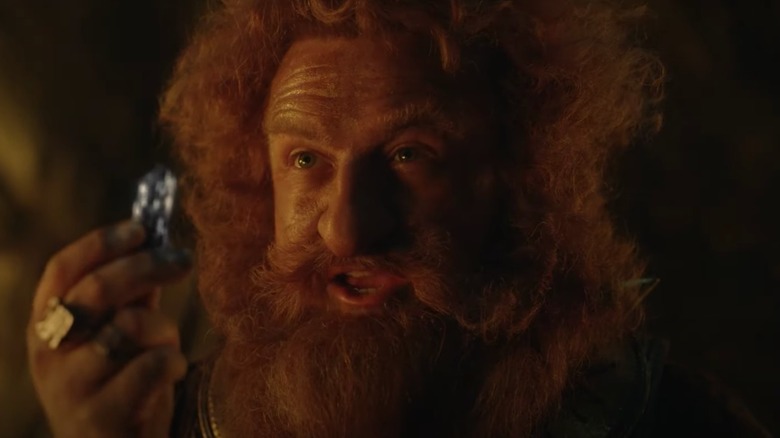How The Rings Of Power's Story Connects To The Hobbit's Thorin Oakenshield
We're soon heading back to Middle-earth, with Prime Video's "The Lord of the Rings: The Rings of Power" expanding on what audiences know of Tolkien's legendarium. The show is set millennia before the events of the live-action films and will tell a vastly different story than any of the two Peter Jackson trilogies. Most excitedly, it will explore untold chapters in the history of Middle-earth.
While we'll get to reunite with fan-favorite characters like Galadriel and Elrond, most other characters are either completely new or only slightly familiar. One of the latter is a dwarf named Durin VI, a character we have never met before but whose name may sound familiar to fans of "The Hobbit." In that film, Thorin Oakenshielf is the leader of Durin's Folk, a clan of dwarves. The name Durin has a long history that is essential to dwarves and the entire Middle-earth. More importantly, it plays a pivotal role in the story of "The Rings of Power" as it connects to the Third Age explored in the films.
A city of wealth and might
Dwarves were actually the first race to be created and sent to Middle-earth by Vala Aulë, but sadly, the supreme being Ilúvatar was a bit of a jerk and had already decided he wanted the elves to be the first to "wake up." This meant that the first ever dwarf, named Durin, had to wait a while ...
After he finally woke up, he walked down until he reached a lake and, upon seeing the stars surround his head in a reflection, took it as a sign that he was to found a city and rule over it. That city was named Khazad-dûm, later known as Moria. Durin's descendants were known as Durin's Folk, or Longbeards, with Durin serving as their king, known as The Deathless. With Khazad-dûm bordering elven kingdoms, Durin's Folk quickly became the friendliest of the dwarves clans to elves and men.
After the War of Wrath and the defeat of the dark lord Morgoth, many dwarves whose cities fell to Morgoth's forces migrated to Khazad-dûm and helped make it the greatest and richest of all dwarven cities.
During the Second Age, kind Durin III became best of friends with the king of Eregion, Celebrimbor, and received one of the seven Rings of Power. Later, during the War of Elves and Sauron, the dwarves of Khazad-dûm aided the elves in their war against Sauron and saved Elrond and his army. This earned them Sauron's eternal hatred, and he sent his orcs to attack and annoy Durin's Folk at every chance they got.
The Second Age ended with Durin IV leading Durin's Folk in joining the alliance of elves and men in defeating Sauron during the War of the Last Alliance.
An age of loss
After a prosperous age, the Third Age brought nothing but misery to Durin's Folk (and everyone else on Middle-earth). The dwarves continued to expand Khazad-dûm and hoard mithril, but eventually, they dug too greedily and too deep and they awoke a Balrog of Morgoth, a huge beast that brought death and destruction upon Khazad-dûm. It killed most of the people in the city, and even slew Durin VI, earning the name Durin's Bane.
After Durin VI's son was also killed, the dwarves abandoned their ancestral home for good, leaving Khazad-dûm to stand dark and empty for centuries, eventually getting renamed Moria — the Black Pit. Led by Thráin I, Durin's Folk relocated to the Lonely Mountain, also known as Erebor, where they created a new kingdom.
As if the loss of one ancestral home wasn't enough, centuries of attacks from dragons and orcs eventually resulted in the dragon Smaug descending upon Erebor and taking the mountain for itself. King Thrór and his people escaped and became nomadic people in exile. Thrór tried to reclaim Moria but was killed by the pale orc Azog. This kickstarted a years-long war between dwarves and orcs.
Thorin and Durin
This finally leads us to Thorin Oakenshield, a prince and grandson of King Thrór. During a battle against orcs, Thorin's shield broke and he managed to use an oaken tree branch as a shield to fend off the attackers, earning the epithet Oakenshield. He was convinced by Gandalf to reclaim Erebor from Smaug, which he succeeded in doing but eventually died during the resulting Battle of the Five Armies.
Now, the reason he isn't named Durin is that the name Durin is more of a title given specifically to kings believed to be the reincarnation of Durin The Deathless.
This makes "The Rings of Power" a bit of a problem, as the show is set to introduce both Durin III and Durin IV as father and son, despite them sharing no blood and being separated by many, many, many years. This is mostly due to the show condensing the millennia of history into a single show for simplicity's sake, and granted, it is possible they never share a scene together, but it is still a lore-breaker.
What's most important is that the two Durins are involved in extremely important times for Durin's Folk: the forging of the rings and the War of the Last Alliance. The time period the show will explore is one of prosperity for Durin's Folk, and most curiously, a time of great friendship between dwarves and elves, a fun respite from the endless bickering between both races in the films.
"The Lord of the Rings: The Rings of Power" premieres on Prime Video September 2, 2022.



